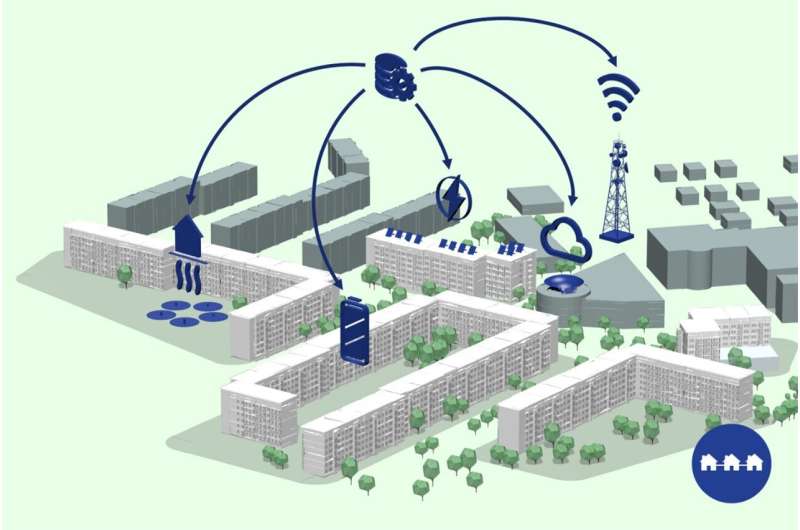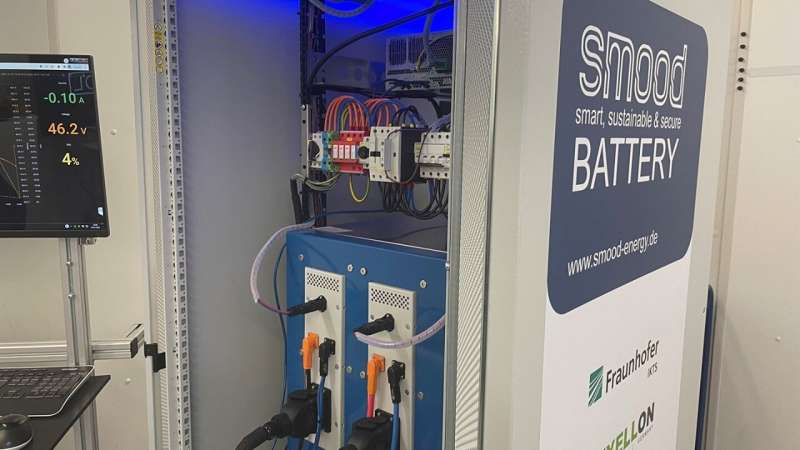This article has been reviewed according to Science X's editorial process and policies. Editors have highlighted the following attributes while ensuring the content's credibility:
fact-checked
trusted source
proofread
Energy-efficient neighborhood redevelopment for affordable housing

In the "smood—smart neighborhood" project, 16 companies, four research institutions and an association have been working together, with the scientific support of Fraunhofer, on the future of energy-related renovation measures over the past few years. Covering everything from digitalized planning processes and innovative district storage systems for electricity and heat to intelligent control and operational management solutions, the project aims to ensure that existing district facilities are ready for the energy transition—and that tenants benefit from lower costs of living as a result.
The cost of electricity, gas and other fossil fuels have increased dramatically in recent months. It is not only since the Russian war of aggression against Ukraine and the associated sanctions that the energy supply in Germany and Europe has faced major challenges. Buildings play a key role in the overall social context: The potential for energy savings is up to 40%, depending on the level and quality of renovations.
Making existing districts energy-efficient, for the benefit of the environment and society
Against this background, the smood—smart neighborhood project was launched in 2019 with a vision of systematically creating value through renovation work in existing residential districts. It is part of the Innovative Regional Growth Cores (Innovative regionale Wachstumskerne) federal funding program, forming a regional alliance of companies, universities of applied science and research institutions in eastern Germany that share a joint technology platform in their region and boost unique selling points in their area of expertise. Until 2022, growth cores of this type received funding from the German Federal Ministry of Education and Research (BMBF).
In addition to its environmental aspects, cost-effectiveness is a crucial criterion for the success of the smood project. By creating a carefully considered mix of innovative energy provision and control technologies with suitable integrated technologies in existing buildings, its ultimate goal is to reduce utility costs. The project aims to achieve this by enabling the districts to cover a large proportion of their energy needs with their own supplies and to provide residents with electricity and heat at an affordable price.
"A vital aim of the growth core as a whole is to combat what are known as segregation effects—that is, situations in which less affluent families can no longer afford to live in certain residential areas," says Prof. Peter Bretschneider, who is both director of the Institute for Advanced Systems Technology (AST) at the Fraunhofer Institute for Optronics, System Technologies and Image Exploitation IOSB and scientific spokesperson for smood.

smood: Five joint research projects, numerous innovations
The partners involved in the technology platform come from the worlds of science, industry and associations and contribute expertise that spans the entire value chain, from surveys, detailed planning and redevelopment in buildings and districts to operational management. They are working together on multiple joint research projects: One of these, smoodPlan, is concerned with district analysis and planning (on a digital basis) using tools such as drones and thermal imaging cameras.
Meanwhile, innovative methods of tapping into heat sources and storing heat are the focal points for GeoHoP (which uses novel drilling technology to install horizontal geothermal probes in a star shape) and GeoHeatStorage (which provides a cost-effective, geothermal method of heat storage in summer and allows heat to be recovered through pumps in winter). The EStorage joint research project, in which the Fraunhofer Institute for Ceramic Technologies and Systems IKTS is taking a leading role, will provide a sustainable, safe and inexpensive sodium-nickel chloride district battery for local storage of electricity obtained from photovoltaic systems, for example. In the smoodACT project, the participants' work involves developing, designing and testing an energy management system for buildings and districts.
"Through smood, we have managed to develop an all-encompassing system that marks an important step toward phasing out fossil fuel energy," says Dr. Kersten Roselt, business spokesperson for smood. "We are starting with some amazing developments, such as drone-supported district planning, new eco-friendly electricity storage systems for districts, geothermal recovery and heat storage methods under existing buildings, plus an intelligent, low-cost energy management system for districts."
smoodACT: Intelligent control of energy flows
Fraunhofer IOSB-AST took up the mantle of coordinating the smoodACT sub-project on the basis of its many years of expertise in energy management systems. One aspect of the work involves evaluating energy flows in districts that have already undergone energy-focused renovations and using algorithms to ensure that energy is available at the points where it can be used as effectively as possible.
For example, it considers whether electricity that is generated by a roof photovoltaic system on a sunny day but is not immediately used should be fed into an energy storage system or used to charge an electric vehicle or operate a heat pump. The data entered enables the energy management system to make automated decisions about the best way to use the available energy in view of the current situation and needs. However, existing systems also need to be adjusted with more efficacy in mind and combined with the new components. By system optimization in this way, it is possible to run equipment with an efficient, eco-friendly approach using local resources. As Prof. Bretschneider states, "Intelligent control systems alone can help buildings use around 30% more local renewable energy."

From the laboratory to real life
Once the consortium—launched in 2019—reached the end of its stage in December 2022, the project partners presented the outcomes and solutions produced so far to the public. As of today, the entire smood concept is ready to undergo full testing in real time under laboratory conditions. The next steps are set to involve launching demonstration projects—in other words, real-life model districts, something that the project participants are already discussing with private and municipal residential companies. According to Prof. Bretschneider, both private businesses and urban development agencies are expressing a keen interest: "We believe that we will see the first projects get up and running for real within the next four to five years." Private companies have even been giving consideration to establishing their own energy companies, an approach that could make it possible to introduce flat energy rates for tenants in the future.
Open District Hub, also launched by the Fraunhofer-Gesellschaft and operating in a similar field, represents a role model for trialing laboratory-developed models in practical scenarios. A non-profit association, it focuses on successfully ushering in the energy transition and developing climate-neutral cities by harnessing synergy effects within districts—created when generating renewable energy or coupling the electricity, heat and mobility sectors, for instance. To assess how innovative solution concepts are put into practice from models, Open District Hub is already working with reference districts that reflect the extensive range of district types out there.
The innovative solutions developed by the smood consortium have aroused interest beyond Thuringia (the federal state in which the project is based) and even Germany as a whole, with inquiries received from the U.S. and Asia region on a regular basis. Prof. Bretschneider adds, "It was a particular honor to present smood as part of the Expo 2020 Dubai."

















